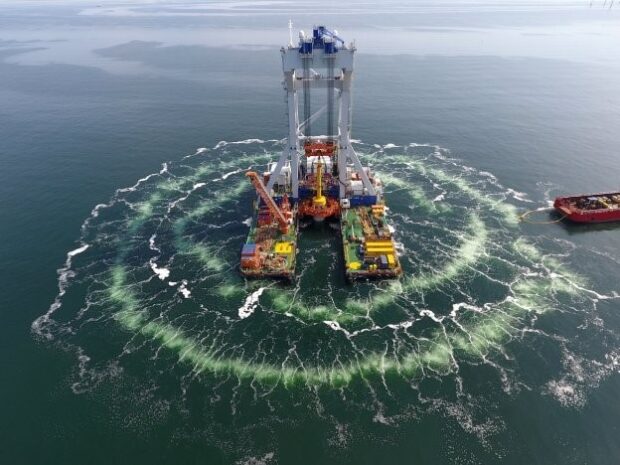On August 3, the New England for Offshore Wind Coalition, Environmental League of Massachusetts, and offshore wind developer Avangrid hosted a boat tour of the construction site for the Vineyard Wind 1 wind farm located 15 miles south of Martha’s Vineyard. On this day, dozens of offshore wind advocates including environmental and conservation organizations, state representatives, union workers, and industry members gathered on the 85-foot Captain John and Son II to learn about the ongoing progress for what will soon be the United States’ largest offshore wind development (for now). For many on board, this was the first time they were able to visit the site and see firsthand what is required to build an offshore wind farm.
Offshore Wind Creates Good Jobs
Vineyard Wind 1 will have 62 turbines, each 850 feet tall and distanced 1 mile from each other. In total, these turbines will generate over 800 megawatts of electricity which will power 400,000 Massachusetts homes. According to the developer, Vineyard Wind 1 will “create 3,600 full-time equivalent jobs and, under the Project Labour Agreement, at least 500 of the jobs created during the construction phase of the project are guaranteed to be filled by local staff and includes high hiring targets for women and various groups facing racial discrimination in the US.” Union labor is also a major part of the project’s workforce, including Piledrivers and Divers Local 56, the International Brotherhood of Electrical Workers Local 223, among other local labor unions to ensure safe working conditions, good pay, and technical ability. The installation of the turbines began in early August. Avangrid is optimistic that power could start being generated by October 2023, with full scale operations by mid-2024.
While tour attendees were too early to see any actual wind turbines, there is already significant infrastructure in place. From the vessel, passengers were able to spot at least six foundations where the turbines will ultimately be installed. These massive structures anchor the turbines in place. In addition, passengers also had the chance to see one of the world’s largest offshore electrical substations. Sitting on a yellow foundation, or “jacket”, made of 2,500 tons of steel, Vineyard Wind’s Deputy CEO Sy Oytan explained that the substation’s top is “as big as an American football field” and includes a helicopter platform. The substation will deliver the electricity from the wind farm through undersea cables into Barnstable where it connects to the regional power grid.
Putting Wildlife and Wildlife Habitat First
The developer also notes that “Vineyard Wind 1 will prevent the emission of more than 1.6 million tons of carbon dioxide every year, the equivalent to withdrawing 325,000 vehicles from the roads, and, during the life of the project, a total of 3,700 million dollars will be saved in energy costs in the region of New England.” In addition to the emissions reductions of Vineyard Wind 1, wildlife protection was also a key feature of ensuring responsible development. Vineyard Wind partnered with the Charles River Association to employ novel technology to detect marine mammals, ships, and fishing gear, allowing the developers to avoid potentially dangerous interactions with wildlife.

These are not the only wildlife protection measures that have gone into the development of this project over the last four years. For example, the developer has employed bubble curtains during pile driving to dampen the noise created, protecting marine wildlife like whales from potential hearing damage or loss. Moreover, Vineyard Wind is taking additional precautions to protect North Atlantic right whales including seasonal pile driving restrictions and comprehensive monitoring to ensure construction does not happen while right whales are in the area.

Vineyard Wind 1 is just the beginning of offshore wind in the U.S. According to recent research, there is so much more potential for offshore wind. The Biden administration has set ambitious, yet feasible, goals for development by 2030 and 2050, and the construction of Vineyard Wind 1 is an important step toward fulfilling them. With new lease areas being auctioned and projects being permitted across the country, there has never been a more exciting and important time to ensure offshore wind is built swiftly and responsibly.
 Offshore Wind Energy
Offshore Wind Energy 

